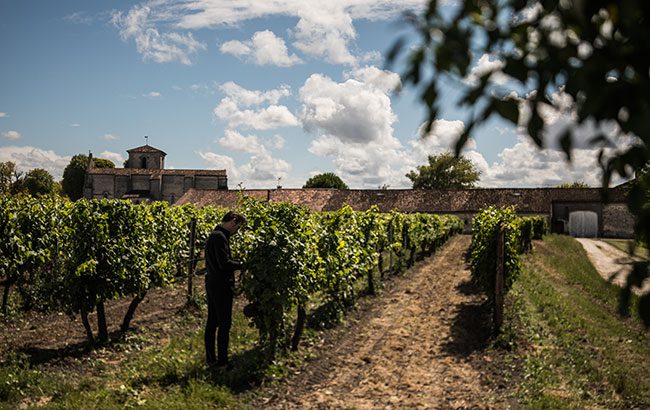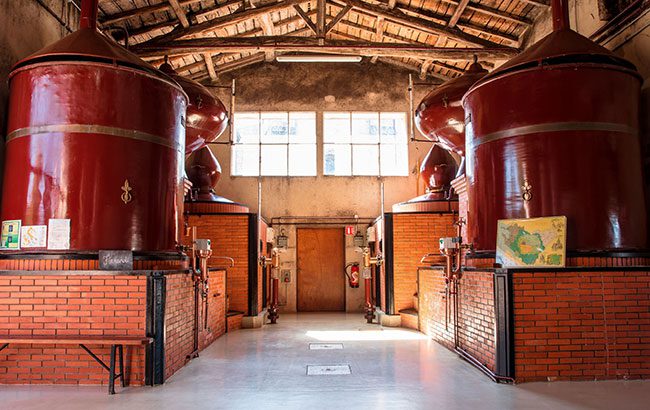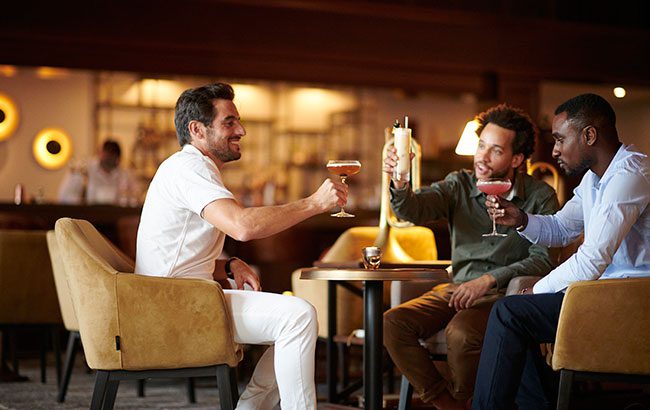This website uses cookies so that we can provide you with the best user experience possible. Cookie information is stored in your browser and performs functions such as recognising you when you return to our website and helping our team to understand which sections of the website you find most interesting and useful.
Cognac: becoming a tourist destination
With an expanding area of vines being planted, producers in Cognac are planning for a healthy future, and that includes enticing consumers to visit the region.

*This feature was originally published in the May 2022 edition of The Spirits Business magazine.
As well as being a global spirit enjoyed from Shanghai to San Francisco and all points in between, Cognac is a wine region. “In France there are about 800,000 hectares of vines,” says Per Even Allaire, deputy commercial director at Cognac AE Dor. “The rules allow for 1% increase per year, so that’s 8,000ha for the whole country, and it’s a good thing for Cognac that not every region is performing as well.”
If the likes of Bordeaux are not expanding, it means Cognac can plant an extra 3,129ha of vineyards this year to bring the total to 83,690ha. “In Cognac when you plant a vine, you won’t gather any fruit for four years,” says Alexandre Gabriel, head of Maison Ferrand, and vice-president of the spirit’s governing body, the BNIC. “Then there’s harvesting and distilling, but that’s just the start. It’s not even Cognac until two years as a minimum for VS, and four for VSOP.”
It is a long-term game, in other words. Gabriel talks of “a 20-year vision”, and says: “I’m 55, and I’m planting grapes for my kids.” For the many growers in the region who supply the big four houses – Hennessy, Martell, Courvoisier and Rémy Martin – expanding the vineyards is a vote of confidence in the Cognac brand. The category saw an impressive bounce last year with exports up by 16% in volume and by 31% in value. According to Gabriel, that is around 3% up on 2019.
Of the 232 million bottles of Cognac shipped in 2021, half went to the US, where, together with brandy, the category was worth US$3.5 billion, according to the Distilled Spirits Council of the US (Discus), placing it fourth behind American whiskey, Tequila and vodka. The most recent figures from Impact Databank for 2020 put Hennessy on 5.1m cases in the US, followed by Rémy Martin on 1.5m and Courvoisier on 907,000. The top six brands all grew last year compared with 2019, apart from Martell, which fell by a quarter to 174,000 cases.
High-end premium
While Discus lumps Cognac and brandy together, the former undoubtedly accounts for the vast majority of the premium-price bands that began to take off in the past six years. Since 2016, ‘high-end premium’ sales have increased by 45.4%, and ‘super premium’ by 112.4%, and together they now make up just over half the total.
In 2020, IWSR Drinks Market Analysis reported Cognac jumped by 18.1% in volume and 17.1% in value in the Americas, the only region to show growth that year. It forecasts that value will continue growing by 3.8% compound annual growth rate through to 2025 in the US, with volume up by 3.9%.
“We’ve seen an acceleration in demand in the past couple of years,” says Allaire about the US. He sees it as part of “the increase in accessible luxury consumption” that occurred during the Covid-19 pandemic. “It even happened in France, which has seen growing demand,” he says. “It’s been a long time since that happened, so we’re very happy for that.”

Gabriel credits the success to the spirit’s versatility as something to sip neat or mix, and he notes how it has managed to surf the American-led resurgence in classic cocktails. “When you go to the US, you really see this deeply-rooted culture into knowing what to do with beautiful Cognacs in bars,” he says. But he is wary about making predictions, especially after this year’s turbulent start.
“It’s hard to bring out a crystal ball,” he says. “We are carefully optimistic as we embrace this culture of high-quality spirits and of good moments shared. And yet we see what is happening with the economy and the destabilising effect of events in Eastern Europe. Some mid-sized and smaller companies have been hit quite hard because they have specialised a bit in Russia and Ukraine.”
As markets they may represent less than 3% of total Cognac sales, “but you have to look at the bigger picture and the whole ripple effect”, says Gabriel, thinking of rising inflation and soaring energy prices.
While he accepts the production costs for the brands on sale were born years ago, in terms of the work in the vineyards and the fuel to fire the stills, he says: “You have to consider everything around it. Cognac is the liquid, but it is also the bottle, the transport and the marketing.”
Supply constraints
As spirits producers know, it is not just a question of having to pay more, you have to get your hands on the goods in the first place, be they glass, cardboard or shipping containers. When LVMH reported Hennessy had slumped by 18% in the first quarter of this year, it blamed “supply and logistic constraints, in the US in particular”.
But with its nearby glass manufacturers, for example, Cognac appears to be better protected than many of its rivals. “We are very lucky to have a rich eco-system of raw-material suppliers,” says Laura Moore, export sales manager at A de Fussigny Cognac.
“For us, it’s been an initiative to source everything we can in France, and we are up to around 90% of what we need. Initially it was to minimise our carbon footprint, but seeing the global situation we are actually pretty happy to bring everything closer.”
For everyone who relies on buying in spirit, and that includes the big four brands, she says: “The price of eaux-de-vie has increased consistently in the last year, and we don’t know where that will go.”
Planting more vineyards may reduce the pressure on supply, but not for quite a few years. As ever, much will depend on demand in the spirit’s other key market, China, which in 2020 accounted for 48% of ‘VSOP and above’ Cognac by value, according to IWSR Drinks Market Analysis.
“Martell is a powerhouse of our Pernod Ricard China business, and has continued to strengthen its leadership position,” said Philippe Guettat, chairman and CEO of Pernod Ricard Asia, last summer. The brand was focused on “two key consumption occasions – premium meals and parties”, he explained, and added: “We have delivered gourmet theatre – a series of Martell pop-up restaurants – and have started a meaningful partnership with the Michelin guide and China’s own Black Pearl restaurant guide.”
Guettat also claimed that Martell had catered to more than “9,000 weddings and banquets” in China. However, the country has since experienced the unwelcome return of Covid-19, and at the time of writing, Shanghai’s 25m citizens were entering their fifth week of lockdown.
“People aren’t able to go out in many regions, and Cognac is something that’s usually shared,” says Moore. “If people can’t get together in a restaurant or at an event, they might not drink Cognac at home by themselves.”

Cognac’s connection with food in China has “been part of the culture for many decades”, says Gabriel. He believes the spirit has the potential to expand into the tier-III and tier-IV cities of Western China, beyond Cognac’s traditional heartland around Shanghai.
“As China develops,” he says, “there’s this deep desire to go with quality products, whether Chinese or international.” Gifting remains very important, particularly for XO Cognacs around Chinese New Year, and while there could be another State-sponsored crackdown on luxury similar to the one of 2012/13, he believes the drink has become more embedded in Chinese culture. “I see it more as part of everyday life, like a reasonable indulgence throughout the year,” he says.
Maison Ferrand previously considered China ‘too branded’ to compete in, but it’s now there through its new distributor, Proof & Co. “The market is still very small for us,” says Angélique Jullienne, the firm’s head of marketing, who senses a shift in consumer behaviour.
“Before, they were only into brands, but the new generation in China is really looking for heritage and history, so there is potential.” And the same goes for new emerging markets in Africa, like Nigeria, which seems to be on everyone’s radar.
Back in France, the Cognac region was “a kind of well-kept secret for quite a while”, admits Alexandre Gabriel, who says: “Cognac is a product of provenance. You experience it when you drink it, but you can experience it by visiting distilleries and by going in the vineyards. Seeing the vines, the grapes and the harvest is not something other spirits can offer. You could walk through fields of maize or barley used to make American whiskey or Scotch, but there would hardly be the same connection. Most Cognac houses are saying ‘we’ve got so much to share, let’s share it’.”
Rebecca Montgomery, brand education manager at Delamain, agrees, adding: “Wine tourism is hugely important – that ability to take people into the cellar and take them on their own sensual journey. We’ve just opened our new tourist centre, and the reason we’re so excited is that we’re going to be able to offer a level of visit designed to really illustrate Cognac’s ability to pair with food.”
As the last Covid travel restrictions disappear, the whole region is gearing up to welcome visitors as never before.

